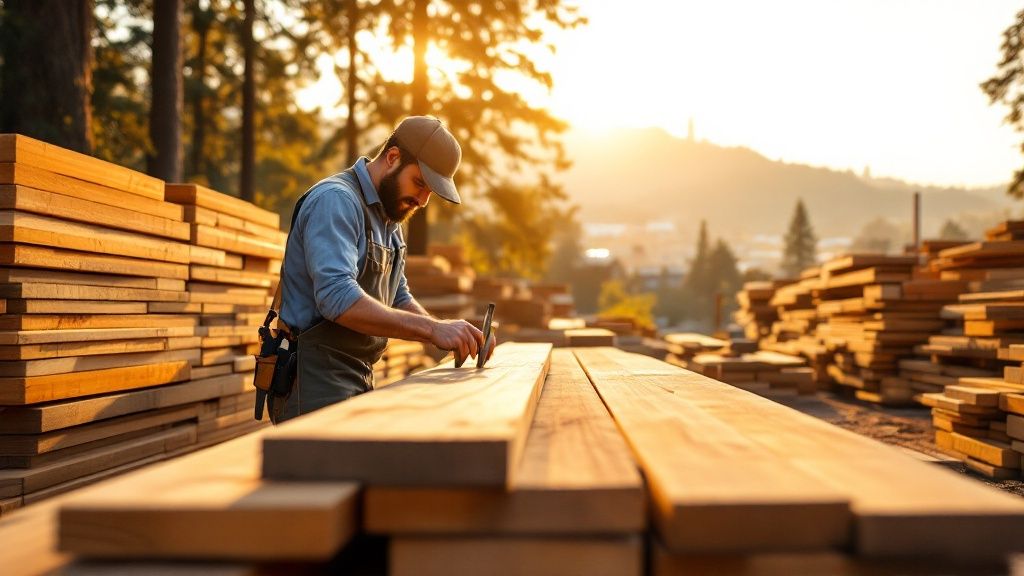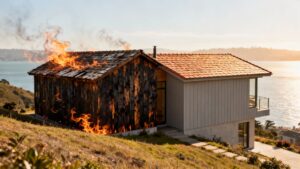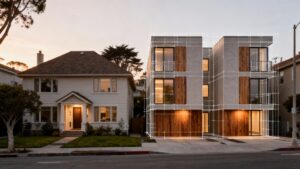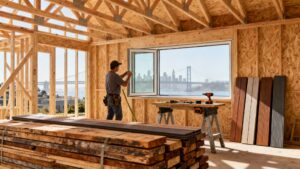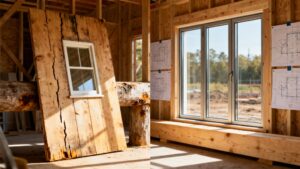Sourcing high-quality lumber is the critical first step for any build in the East Bay. The right wood guarantees durability, beauty, and structural integrity for years to come. Whether you’re framing a new home in Oakland, building a redwood deck in Berkeley, or tackling a remodel in San Francisco, quality materials make all the difference.
Your project's success rests on materials that can handle our local climate and meet high performance standards. This guide will help you choose the best lumber for your job.
Benefits of Using High-Quality Lumber in the Bay Area
Choosing lumber is a serious investment in your project's longevity. For contractors, builders, and homeowners across the Bay Area, this decision impacts structural safety and the final look. A successful project always starts with a solid understanding of wood selection.
This guide is your roadmap to sourcing the best quality lumber East Bay suppliers offer. We'll cover everything from species and grades to how our unique microclimates affect wood performance. You'll gain the confidence to make the right call every time.
What Defines Quality Lumber?
So, what should you look for at the lumberyard? Quality is a combination of physical traits that tell you how the wood will perform. Using the right material ensures your structure is sound, looks incredible, and will stand for decades.
Here are the key indicators of quality:
- Straightness and Stability: You want boards that are straight, without major twisting, bowing, or cupping. This makes installation easier and gives you a cleaner, professional finish.
- Minimal Defects: Look for lumber with few knots, splits, or wanes (bark on the edges). While all wood has character, high-grade material has fewer imperfections.
- Correct Moisture Content: Properly dried wood is more stable and less likely to shrink or warp after installation. This is crucial in the Bay Area, where humidity can fluctuate.
- Sustainable Sourcing: Many builders and homeowners now prioritize materials from responsibly managed forests. Choosing an eco-friendly lumber supplier in the East Bay aligns your project with important green building practices.
The goal is to use materials that are strong, stable, and suited for the job. Taking extra time to select quality lumber prevents costly callbacks and ensures a final product you can be proud of. Partnering with a knowledgeable local supplier is your best strategy for success.
How the Bay Area Became a Lumber Hub

The East Bay has a long history as a construction powerhouse. Our story is tied to the California timber industry, which began during the Gold Rush in the mid-1800s. This era turned the region into a center for building materials.
The East Bay's strength was its location. With deep-water ports and rail lines, it became the perfect hub for lumber distribution. Redwood and Douglas-fir from northern forests were shipped here to be milled and sent out across the region.
The Gold Rush Effect on Bay Area Building
The Gold Rush created a massive demand for lumber to build cities like San Francisco almost overnight. According to historical data, San Francisco's population exploded from around 2,000 in 1849 to over 59,000 by 1855. This rapid growth created an urgent need for housing and infrastructure.
The demand put incredible pressure on the timber industry. In a single year, lumber prices shot up from $50 to a staggering $500 per thousand board feet. The East Bay's access to shipping routes made it an essential link in the supply chain that fueled this growth.
A Legacy of Quality and Sustainability
This history set a high standard for building materials. Builders and architects have long relied on the strength and durability of locally processed redwood and Douglas-fir. These qualities are just as critical on today's job sites in Oakland and Berkeley.
Today, that legacy of quality is paired with a commitment to sustainability. Bay Area builders often lead the way in environmentally smart construction. Projects now aim for high standards of energy efficiency and low environmental impact, guided by certifications. To learn more, check out our guide on what LEED certification is to see how it applies to modern building.
Decoding Lumber Grades for Your East Bay Project
Understanding lumber grades is the secret to getting the right performance without overpaying. The stamps on boards, like "Select Structural" or "No. 2," tell you everything you need to know. A grade stamp is like a report card for a piece of wood.
This system, overseen by groups like the Western Wood Products Association (WWPA), helps you choose the right board for the right job. You won't waste money on a flawless board that will be hidden inside a wall. More importantly, it prevents you from using a weaker board for a critical beam, which could compromise safety.

Structural vs. Appearance Grades
Lumber is split into two main categories: structural and appearance. Each has its own grading scale focused on different qualities.
Structural lumber is graded on its strength and integrity. It forms the skeleton of a building, like the framing for walls, floors, and roofs. The grades tell you how much load the wood can handle.
Appearance-grade lumber is all about looks. It is used for things people see, such as trim, siding, decking, and cabinets. These boards are chosen for their clean finish, attractive grain, and minimal blemishes.
Common Lumber Grades You'll Encounter
When you source quality lumber East Bay suppliers carry, you'll see a few common grades. Knowing them helps you communicate with your supplier and get what your plans require. Here is a simple breakdown of common grades for your Bay Area project.
Common Lumber Grades and Their Uses
| Lumber Grade | Typical Appearance | Common Application | Strength Rating |
|---|---|---|---|
| Select Structural | Minimal knots, very straight grain. The highest-quality structural lumber. | Beams, headers, trusses, and engineered components requiring maximum strength. | Highest |
| No. 1 | Sound, tight knots. Still very strong and dependable. | Joists, rafters, and framing where strength is a primary concern. | High |
| No. 2 | More knots and wane are allowed, but still strong. The workhorse of construction. | General framing, walls, plates, and studs. The go-to for most residential projects. | Medium |
| Stud Grade | Straight enough for vertical loads, may have more cosmetic defects. | Exclusively for vertical use in wall framing. | Rated for Studs |
| Clear Redwood/Cedar | Virtually free of knots or blemishes. A premium, beautiful look. | High-end decking, siding, trim, and outdoor furniture. | Not Rated for Strength |
For a deeper dive into how these grades apply to framing, you can learn more about framing lumber grades in our detailed guide. Making an informed choice ensures your project is both structurally sound and looks fantastic.
Choosing Lumber That Lasts in the East Bay Climate

The Bay Area is famous for its microclimates. The constant swing from damp fog to dry heat puts a serious strain on building materials. Choosing the right lumber for this environment is essential for building anything that lasts.
The wrong choice can lead to warped decks, rotted fences, and pest problems. When you select climate-appropriate quality lumber East Bay builders rely on, you ensure your project will stand strong for decades.
Selecting Wood for Exterior Applications
For exterior projects like decks, fences, and siding, moisture is the biggest enemy. You need wood that can naturally fight off water and pests.
- Redwood: A true Bay Area classic, redwood contains natural tannins that make it resistant to rot and termites. It is also very stable and less likely to twist or split.
- Cedar: Like redwood, cedar has natural oils that protect against decay and insects. It's a great choice for siding and outdoor structures because it’s both lightweight and durable.
The Role of Pressure-Treated Lumber
For any wood that touches the ground directly, like fence posts or deck footings, pressure-treated lumber is a must. This lumber is infused with preservatives for maximum protection against rot and termites. It provides an essential shield for the most vulnerable parts of your structure.
Interior Stability and Material Choices
Even indoors, wood can swell and shrink with humidity changes. This can cause gaps in trim, flooring, and cabinets. For these jobs, stability is key.
Dense hardwoods like oak and maple are great for flooring because they hold their shape. For top-tier stability, engineered wood products are an outstanding solution. Check out our guide on what engineered wood is to learn how its construction makes it resistant to warping.
Pro Tip: Always let your lumber acclimate on the job site for a few days before installation. This gives the wood time to adjust to the home's temperature and humidity, reducing the risk of shrinking or warping.
Working With a Knowledgeable East Bay Lumber Supplier
Choosing the right lumber is only half the battle. A top-notch East Bay lumber supplier is a critical member of your team who can save you time and prevent costly mistakes. An established local lumberyard in Berkeley or Oakland has staff with deep industry experience.
They understand regional building codes, our unique microclimates, and how different wood species perform. That kind of expertise is invaluable for any builder, remodeler, or homeowner.
More Than Just a Transaction
A great supplier offers more than just a wide selection of quality lumber East Bay professionals need. They provide services that make your whole process smoother.
Look for a supplier that offers:
- Expert Advice: Their team can answer tough questions, from the best siding for foggy Berkeley mornings to the right structural grade for a seismic retrofit.
- Material Take-Offs: An experienced supplier can review your blueprints and calculate the exact amount of material you need, reducing waste.
- Reliable Delivery: A good partner has the logistics to get your materials to your job site on time, every time.
The Value of a Local Partner
Working with a local East Bay supplier gives you access to community-specific knowledge. They know which materials have a proven track record in our area. Their reputation is built on the success of local projects, so they have a vested interest in your results.
This partnership is like finding a trustworthy general contractor. Both roles demand expertise and reliability. For tips on finding a pro, check out our guide on how to choose a contractor.
Your supplier should be a strategic asset. They help you source the best materials for your budget and deliver peace of mind. For expert advice, visit the Truitt & White showroom in Berkeley to start the conversation.
Frequently Asked Questions About East Bay Lumber
Picking the right lumber is a big deal, affecting your budget, timeline, and final quality. Here are answers to some of the most common questions we hear from builders, architects, and homeowners.
What is the best type of lumber for a deck in the Bay Area?
For a deck that can handle our microclimates, redwood and cedar are top choices. Both have natural oils that make them resistant to rot and insects. Many pros in Berkeley and Oakland use pressure-treated lumber for the substructure and finish the top with beautiful redwood or cedar for a durable and stunning result.
Do I need pressure-treated lumber for my project?
Yes, for certain parts of your build, pressure-treated (PT) lumber is required. Any wood in direct contact with the ground, such as fence posts or deck footings, must be pressure-treated. The treatment protects wood from decay and pests and is often required by local Bay Area building codes.
How can I ensure my lumber is sustainably sourced?
To ensure your lumber is responsibly sourced, look for a stamp from the Forest Stewardship Council (FSC). An FSC mark guarantees the wood came from a forest managed to protect biodiversity. A knowledgeable local supplier like Truitt & White can also guide you to products that meet your project's green building goals.
Why do lumber prices fluctuate so much?
Lumber is a commodity, so its price changes based on supply and demand. Housing market trends, seasonal construction rushes, and transportation costs all affect pricing. According to a U.S. Forest Service report, California's historic lumber production has a direct impact on the prices you see today. You can read more about California's historic lumber production here.
What is the difference between appearance and structural grade lumber?
The main difference is their purpose. Structural grade lumber is rated for strength and is used for the building's frame—the walls, floors, and roof. Appearance grade lumber is graded on its looks and is used for visible elements like trim, siding, and cabinets where a clean finish is important.
For nearly 80 years, Truitt & White has been the trusted partner for contractors, builders, and homeowners across the East Bay. Our knowledgeable team is ready to help you select the perfect high-quality lumber for your next project. Visit our Berkeley showroom or get in touch with our experts today.


